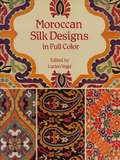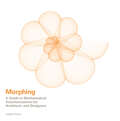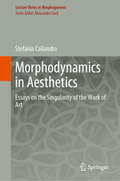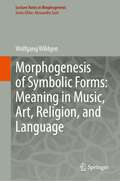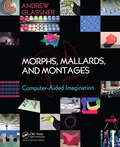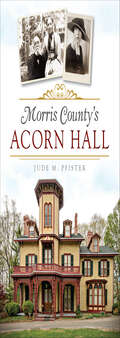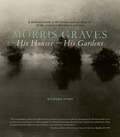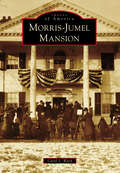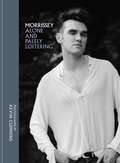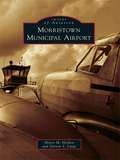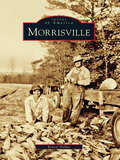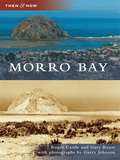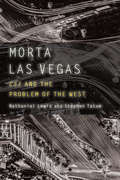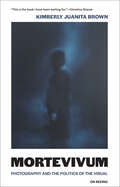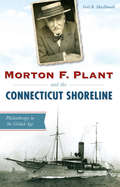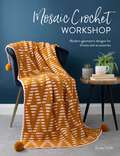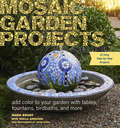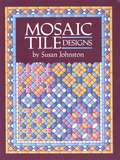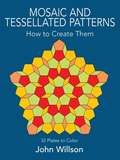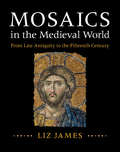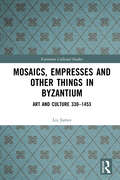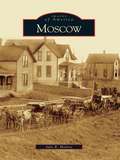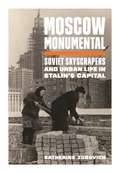- Table View
- List View
Moroccan Silk Designs in Full Color (Dover Pictorial Archive)
by Lucien VogelGathered from a rare French portfolio, here are 59 exquisite, royalty-free motifs — mainly florals and foliates — incorporating Romanesque, Byzantine, Persian, Far Eastern, and traditional Moroccan motifs.Fès (Fez), one of the oldest and most important cities in Morocco, has long been a center for the practice of Islamic crafts, including brasswork, leatherwork, pottery, textiles, and embroidery. Among the most admired textiles produced in the city are the ornamental belts women wear under their caftans on festive occasions. Originally the designs were simple and the colors somber, but over the years the complexity of design increased and the colors became more flamboyant. One startling effect is the sudden change of coloration of a pattern in the same belt, as shown in several of the plates included here. In some instances, there is a sudden discontinuity of pattern within one woven fabric; in others, two patterns from two fabrics sewn together.At the center of commerce in the Near East, Fès was subject to many influences, some of which — including Romanesque, Byzantine, Persian, Rhodian, and Far Eastern textiles — are reflected in these designs. Two motifs are typically Moroccan: a combination of the hand of Fatima and Solomon's Seal; and the mihrab and minbar of mosque architecture.
Morphing: A Guide To Mathematical Transformations For Architects And Designers
by Joseph ChomaCylinders, spheres and cubes are a small handful of shapes that can be defined by a single word. However, most shapes cannot be found in a dictionary. They belong to an alternative plastic world defined by trigonometry: a mathematical world where all shapes can be described under one systematic language and where any shape can transform into another.This visually striking guidebook clearly and systematically lays out the basic foundation for using these mathematical transformations as design tools. It is intended for architects, designers, and anyone with the curiosity to understand the link between shapes and the equations behind them.
Morphing: A Guide to Mathematical Transformations for Architects, Designers
by Joseph ChomaCylinders, spheres and cubes are a small handful of shapes that can be defined by a single word. However, most shapes cannot be found in a dictionary. They belong to an alternative plastic world defined by trigonometry: a mathematical world where all shapes can be described under one systematic language and where any shape can transform into another.This visually striking guidebook clearly and systematically lays out the basic foundation for using these mathematical transformations as design tools. It is intended for architects, designers, and anyone with the curiosity to understand the link between shapes and the equations behind them.
Morphodynamics in Aesthetics: Essays on the Singularity of the Work of Art (Lecture Notes in Morphogenesis)
by Stefania CaliandroThis book deals with the complexity of art by focusing on the singularity of the work of art. Gathering a selection of writings in art theory and semiotics, it explores the question of apprehending art from its perceptual aspects to aesthetic comprehension and understanding. Theoretical enquiries focus in particular on the dynamics of the perception of forms, the semiotic value of colour, the aesthetic phenomenon of empathy, the function of vision in relation to other senses and its faculty to lead, in a substantial way, to the embodiment of sense. These theoretical points are constantly observed with reference to the analysis of works of art, especially from the beginning of the modern era, when a renovated psychophysical approach oriented the evolution of contemporary aesthetics. Research into art theories sheds light on how differentials in topologic positions, dimensions, relationships and tones contribute to the arising of forms and colours in perception, and affect the perceiver. The essays presented address in different ways the emergence of sense, by conceiving it as deeply anchored to the dynamics of perception, in addition to the cognitive disposition and knowledge, regardless of whether or not the subject (artist or beholder) is aware of these processes. Through in-depth analyses identifying to what extent the aesthetic moment builds on perceptual and semiotic processes, works of art are revealed to be singularities, reflecting the correlation with morphodynamics in the sciences.
Morphogenesis of Symbolic Forms: Meaning in Music, Art, Religion, and Language (Lecture Notes in Morphogenesis)
by Wolfgang WildgenIn the present book, the starting line is defined by a morphogenetic perspective on human communication and culture. The focus is on visual communication, music, religion (myth), and language, i.e., on the “symbolic forms” at the heart of human cultures (Ernst Cassirer). The term “morphogenesis” has more precisely the meaning given by René Thom (1923-2002) in his book “Morphogenesis and Structural Stability” (1972) and the notions of “self-organization” and cooperation of subsystems in the “Synergetics” of Hermann Haken (1927- ). The naturalization of communication and cultural phenomena is the favored strategy, but the major results of the involved disciplines (art history, music theory, religious science, and linguistics) are respected.Visual art from the Paleolithic to modernity stands for visual communication. The present book focuses on studies of classical painting and sculpture (e.g., Leonardo da Vinci, William Turner, and Henry Moore) and modern art (e.g., Jackson Pollock and Joseph Beuys). Musical morphogenesis embraces classical music (from J. S. Bach to Arnold Schönberg) and political songwriting (Bob Dylan, Leonhard Cohen). The myths of pre-literary societies show the effects of self-organization in the re-assembly (bricolage) of traditions. Classical polytheistic and monotheistic religions demonstrate the unfolding of basic germs (religious attractors) and their reduction in periods of crisis, the self-organization of complex religious networks, and rationalized macro-structures (in theologies). Significant tendencies are analyzed in the case of Buddhism and Christianism. Eventually, a holistic view of symbolic communication and human culture emerges based on state-of-the-art in evolutionary biology, cognitive science, linguistics, and semiotics (philosophy of symbolic forms).
Morphological Regionalization: Strengthening the Conzenian Method (The Urban Book Series)
by Muzaffer Ali AratThis book is about how to make the method of morphological regionalization, proposed in the early 1960s, more useful and practicable for planning, urban design and architecture. This book is about cities; more precisely, about how cities can be characterized based on the main elements of urban form. It provides a systematic way of description and explanation of the historico-geographical structure of the urban landscape. It offers a step-by-step methodology for the identification of morphological regions as a key tool for planning practice and townscape management. The book is divided in seven parts. The first part is the introduction, motivation, research goal and objectives, and the structure of the book. The second part of the book offers an overview of urban morphology, urban morphological approaches, the concept of morphological region and its past applications worldwide. The third part is the methodological procedures for the implementation of this morphological approach to cities. The fourth and fifth parts are the implementation of this methodology into two case studies, Istanbul and Antequera. The sixth part offers a discussion of results. And, finally, the seventh part is constituted by a set of conclusions.
Morphs, Mallards, and Montages: Computer-Aided Imagination
by Andrew GlassnerThis book is for everyone who's interested in computer graphics and how it can take us on exciting journeys powered by imagination and a love of discovery and invention. Each chapter investigates a unique topic and gives you the tools to continue that exploration on your own. Examine the possibilities of: - Pop-up books and cards - Reconstructing shredded documents - Crop circles - Weaves and Tartans - Morphing images and much more! Browse and enjoy the array of visual ideas or roll up your sleeves and write your own code.
Morris County's Acorn Hall (Landmarks)
by Jude M. PfisterAcorn Hall has always been a home. In 1852, Dr. John Schermerhorn conceived the sprawling estate and mansion, and he spent four years decorating it in a lavish Rococo style. Banker Augustus Crane later bought the estate and mansion, had it redesigned and rechristened it Acorn Hall, and it remained in his family through two world wars and numerous financial crises. Mary Crane Hone donated the landmark to the Morris County Historical Society in 1971. After its devoted members lovingly restored the hall, it became a focal point for the community and a beautiful setting for the society's collections. Today, it is imbued with a sense of purpose, tradition and reverence for the past. Local historian Jude Pfister tells the remarkable story of Morris County, New Jersey's Acorn Hall.
Morris Graves: His Houses, His Gardens
by Richard SvareAuthor Svare tells the compelling story of the creation and renovation of residences that were home to Morris Graves, a leading figure in Northwest Art and one of the most important American artists of the twentieth century. This insightful rendering contains never before published photographs and a captivatingnarrative.
Morris-Jumel Mansion
by Carol S. WardMorris-Jumel Mansion is an engaging look at the history of Manhattan's oldest residence. Built by Roger Morris in 1765 as a summer estate, it has truly been a witness to history throughout the last 250 years. Located in the upper Manhattan neighborhood of Washington Heights, the mansion sits on a large hill, with sweeping views of both the East and Hudson Rivers. George Washington strategically located his headquarters here during the fall of 1776, but the Jumels, who made the house their home from 1810 to 1895, left the most indelible mark. In 1904, the residence became a museum, thanks to the Daughters of the American Revolution, who saved the house and allowed it to grow with the changing neighborhood. Today, this landmark is a symbol of both the long history of the city and the contemporary face of its now diverse neighborhood.
Morrissey: Alone and Palely Loitering
by Kevin Cummins'One of the greatest music photographers of all time...this book is indispensable to anyone who is a fan of Morrissey, or of great photography 'Classic Pop magazine'Unsurprisingly, given Cummin's history, the photographs are beautifully composed, from the live shots with their webbing of shredded shirts and outstretched arms to the lyrical portraits on staircases or Japanese streets'Q MagazineTaken by renowned photographer Kevin Cummins and featuring hundreds of previously unseen images, Alone and Palely Loitering chronicles Morrissey's world as he emerged from The Smiths and established himself as a solo artist.Breathtaking photographs cover chaotic live performances, intimate portrait sessions and snatched moments backstage and on tour over a ten-year period. Cummins provides insightful commentary on the art of photography and what it was like to work and travel with Morrissey.The book also includes portraits of from fans around the world with Morrissey-inspired tattoos, featuring an essay by literary academic Dr Gail Crowther exploring how this art form is used to display devotion to a unique musician.
Morristown Municipal Airport (Images of Aviation)
by Henry M. Holden Darren S. LargeOn July 8, 1929, a Morristown newspaper announced the opening of Morristown Airport on Bernardsville Road. The article stated the airport would be the home of the Country Aviation Club under the supervision of Clarence Chamberlin, the second man to fly across the Atlantic Ocean and the first to take along a passenger. The Great Depression halted any serious development of the airport until 1936, when there was serious talk of the land becoming an East Coast dirigible base for the Hindenburg. However, the destruction of the Hindenburg at Lakehurst, New Jersey, a year later squashed those plans. After World War II, Morristown Airport began to become a reality. General aviation found Morristown convenient and out of the traffic patterns of Newark Airport. The airport grew and prospered, and by July 1966, Morristown Municipal Airport (MMU) was called the "VIP Stop." Today, as a general aviation reliever airport, MMU accepts private, corporate, air taxi, air ambulance, training, and military aircraft and ranks 11th in general aviation operations.
Morrisville
by Ernest DollarMorrisville is known as a small, sleepy town in central North Carolina. However, this town in the heart of the state's most technological area has a long and colorful past. The Morrisville community traces its origin to its location on the state's colonial east-west road and became a town, naming itself after resident Jeremiah Morris, with the arrival of the North Carolina Railroad in 1852. Its strategic stop along the railroad brought warring armies during the Civil War, and afterward, residents hoped the railroad would make Morrisville a prosperous town of the New South. Progress came slowly, and Morrisville became a farming community frozen in time for the next 100 years. With the rapid growth of the Research Triangle in the 1980s, Morrisville found itself enveloped by a quickly changing community. Located by the state's largest airport and a major interstate, Morrisville became the new center for several technologically advanced research facilities and home to many new families enjoying the town's rural charm.
Morro Bay
by Garry Johnson Gary Ream Roger CastleMorro Bay began as a coastal fishing and farming village. Today it is a well-known vacation destination. At its heart, it has changed little since John Riley first envisioned it in 1872. The community has had brushes with dramatic change, but fate has allowed it to remain a typical American small town. Author Roger Castle was born and raised in Morro Bay. Coauthor Gary Ream and photographer Garry Johnson are relative newcomers. Through their eyes, here is a view of a modern, but ageless Morro Bay.
Morta Las Vegas: CSI and the Problem of the West (Postwestern Horizons)
by Nathaniel Lewis Stephen TatumThrough all its transformations and reinventions over the past century, “Sin City” has consistently been regarded by artists and cultural critics as expressing in purest form, for better or worse, an aesthetic and social order spawned by neon signs and institutionalized indulgence. In other words, Las Vegas provides a codex with which to confront the problems of the West and to track the people, materials, ideas, and virtual images that constitute postregional space.Morta Las Vegas considers Las Vegas and the problem of regional identity in the American West through a case study of a single episode of the television crime drama CSI: Crime Scene Investigation. Delving deep into the interwoven events of the episode titled “4 × 4,” but resisting a linear, logical case-study approach, the authors draw connections between the city—a layered and complex world—and the violent, uncanny mysteries of a crime scene. Morta Las Vegas reveals nuanced issues characterizing the emergence of a postregional West, moving back and forth between a geographical and a procedural site and into a place both in between and beyond Western identity.
Mortevivum: Photography and the Politics of the Visual (On Seeing)
by Kimberly Juanita BrownA powerful examination of the unsettling history of photography and its fraught relationship to global antiblackness.Since photography&’s invention, black life has been presented as fraught, short, agonizingly filled with violence, and indifferent to intervention: living death—mortevivum—in a series of still frames that refuse a complex humanity. In Mortevivum, Kimberly Juanita Brown shows us how the visual logic of documentary photography and the cultural legacy of empire have come together to produce the understanding that blackness and suffering—and death—are inextricable. Brown traces this idea from the earliest images of the enslaved to the latest newspaper photographs of black bodies, from the United States and South Africa to Haiti and Rwanda, documenting the enduring, pernicious connection between photography and a global history of antiblackness.Photography's history, inextricably linked to colonialism and white supremacy, is a catalog of othering, surveillance, and the violence of objectification. In the genocide in Rwanda, for instance, photographs after the fact tell viewers that blackness comes with a corresponding violence that no human intervention can abate. In Haiti, the first black republic in the Western Hemisphere, photographic &“evidence&” of its sovereign failure suggests that the formerly enslaved cannot overthrow their masters and survive to tell the tale. And in South Africa and the United States, a loop of racial violence reminds black subjects of their lower-class status mandated via the state. Illustrating the global nature of antiblackness that pervades photographic archives of the present and the past, Mortevivum reveals how we live in a repetition of imagery signaling who lives and who dies on a gelatin silver print—on a page in a book, on the cover of newspaper, and in the memory of millions.The URL for this publication is https://on-seeing-mortevivum.org/.
Morton F. Plant and the Connecticut Shoreline: Philanthropy in the Gilded Age
by Gail B. MacdonaldGilded Age financier Morton F. Plant inherited his father’s transportation empire determined to improve his community. A dreamer eager to invest in innovative technology and grass-roots community causes alike, Plant’s influence ran deep on the Connecticut shoreline prior to World War I, and his legacy remains prominent. Plant’s summer mansion, Branford House, is one of southeastern Connecticut’s iconic landmarks. He was instrumental in founding the prestigious Connecticut College. And the Shennecossett Golf Club he developed as part of his summer resort is a popular public course. Gail Braccidiferro MacDonald brings to life this important figure in Connecticut history and demonstrates his long-reaching impact.
Mosaic Crochet Workshop: Modern geomretric designs for throws and accessories
by Esme CrickCreate sensational crochet throws and accessories with this indispensable guide to mosaic crochet. Mosaic crochet is a cutting-edge technique that allows you to work two-colour patterns without having to change yarns in one row. You simply skip stitches in one row and connect them by filling in with the alternate colour two rows later. This produces incredible modern geometric patterns that look amazing as throws, blankets, afghans, pillows, rugs, bags and other accessories ; using a much easier method than other crochet colourwork techniques.One crochet hook and two balls of yarn are all you need to get started. While it might look complex, mosaic crochet is actually incredibly straightforward once you learn the basic techniques. If you can work a chain, a double crochet (US single crochet) and a treble crochet (US double crochet), then you can mosaic crochet (...and if you can't, don't worry, all the stitches you need are covered in the book). And what's even better is that there are minimal ends to sew in because it works on a two-row method with the yarn carried up the side of the work. In the only book on the subject, crochet designer Esme Crick of Red Sparrow Crochet, shows you how to make 12 bold, statement throws and then how to use the same pattern to create a further 12 spin-off designs for smaller projects, showing how using different yarn colours with the same pattern can create completely different results. In Mosaic Crochet Workshop, Esme shares her skills, passion and gentle humour with you, so that you too can create beautiful throws and stylish homewares whatever your crochet level. And it's not just about slavishly following a pattern, but about building your confidence to make these designs your own, exploring the possibilities of colour and being inspired to start your own design adventures along the way. With full step-by-step guidance on the mosaic stitch, charts for all the mosaic crochet patterns, and 24 projects to make with full written patterns, this stylish modern crochet book will change the way you approach crochet colourwork forever and give you a wealth of beautiful throws and accessories for your home.
Mosaic Garden Projects: Add Color to Your Garden with Tables, Fountains, Bird Baths, and More
by Mark Brody Sheila Ashdown“This thorough guide to techniques, tools, and materials is filled with expert tips and tricks. The detailed project instructions will inspire you to make your own mosaicked mark on the landscape.” —Lorene Edwards Forkner, author of Handmade Garden Projects In Mosaic Garden Projects, artist Mark Brody walks step-by-step through the creation of 25 decorative yet functional projects. With simple ideas like address signs and stepping stones to more complex projects such as an orb fountain, Brody also includes with a primer on the fundamentals of mosaic and information on the range of possible materials. Project templates are included along with instructions on how to scale each project. Mosaic Garden Projects is packed with inspiration that will brighten the garden all year long.
Mosaic Tile Designs
by Susan JohnstonRich source of royalty-free design ideas. Circles, squares, rectangles, and other geometric figures combined in intricate patterns, symmetrical motifs, interlocking figures, etc. Rich, varied, complex -- ideal for stained glass, textile, wallpaper, and other arts and crafts uses.
Mosaic and Tessellated Patterns: How to Create Them, with 32 Plates to Color (Dover Art Instruction)
by John WillsonAs old as ancient Rome, tessellated patterns can be seen in many places today: in Victor Vasarely's black-and-white paintings, in the designs of Ensor Holiday and M. C. Escher, in Spirograph drawings, and even in computer. John Willson, a research chemist, artist, and teacher, has been creating these dazzling "op art" designs for years. Now, he brings his special expertise to this unusual coloring book. Here you'll find complete information on tessellations and their creation, including:* Definition of a tessellation* History of tessellated designs, beginning with their origin in Rome* Basic kinds of tessellations and how they are formed* Detailed instructions for creating your own unique designs from common geometrical shapesA full 179 figures illustrate the clearly written text. Also included is a special section of 32 full-page plates of tessellations, ready to be colored any way you wish. This is your best introduction to an unusual and rewarding pastime that will afford you many hours of creative satisfaction.
Mosaics in the Medieval World: From Late Antiquity to the Fifteenth Century
by Liz JamesIn this book, Liz James offers a comprehensive history of wall mosaics produced in the European and Islamic middle ages. Taking into account a wide range of issues, including style and iconography, technique and material, and function and patronage, she examines mosaics within their historical context. She asks why the mosaic was such a popular medium and considers how mosaics work as historical 'documents' that tell us about attitudes and beliefs in the medieval world. The book is divided into two part. Part I explores the technical aspects of mosaics, including glass production, labour and materials, and costs. In Part II, James provides a chronological history of mosaics, charting the low and high points of mosaic art up until its abrupt end in the late middle ages. Written in a clear and engaging style, her book will serve as an essential resource for scholars and students of medieval mosaics.
Mosaics, Empresses and Other Things in Byzantium: Art and Culture 330 – 1453 (Variorum Collected Studies)
by Liz JamesThis volume consists of 15 articles published between 1991 and 2018. It falls into three sections, reflecting different areas of Liz James’s interests.The first section deals with light and colour and mosaics: four articles considering light and colour in mosaics and the making of mosaics, as well as the question of what it means to define mosaics as ‘Byzantine’ are reprinted. The second brings together four pieces on empresses: their relationships with female personifications and the Mother of God; their roles in founding and refounding buildings; and their employment as ciphers by some authors. Finally, seven papers cover a range of topics: what monumental images of saints in churches might have been for; what the differences between relics and icons might have been; how captions to images can be misleading; why touch was an important sense; how words can sometimes ‘just’ be decorative rather than for reading; why the materiality of objects makes a difference. There is also a brief section of additional notes and comments which add to, update and reflect on each piece now in 2024.Mosaics, Empresses and Other Things in Byzantium will be of interest to scholars and students alike interested in material culture, the depiction of regal women, and the use of relics and icons in the Byzantine Empire.
Moscow
by Julie R. MonroeEach spring for centuries, the Nez Perce Indians visited the area they called Taxt-hinma (place of the spotted deer) to harvest the camas root. Today Taxt-hinma is Moscow, Idaho, a forward-looking university community dedicated to preserving the spirit of place that attracted the area's first permanent settlers in 1871. Originally known as Paradise, Moscow started out as a trading center serving homesteaders settling the prodigiously fertile Palouse. Since its incorporation as a city in 1887, Moscow has grown steadily upon a foundation of education and agriculture. From its central core of notable commercial and public buildings to the splendid houses that once sheltered its founders to the scenic University of Idaho campus, Moscow is clearly a community that values its cultural, economic, architectural, and natural heritage.
Moscow Monumental: Soviet Skyscrapers and Urban Life in Stalin's Capital
by Katherine ZubovichAn in-depth history of the Stalinist skyscraperIn the early years of the Cold War, the skyline of Moscow was forever transformed by a citywide skyscraper building project. As the steel girders of the monumental towers went up, the centuries-old metropolis was reinvented to embody the greatness of Stalinist society. Moscow Monumental explores how the quintessential architectural works of the late Stalin era fundamentally reshaped daily life in the Soviet capital.Drawing on a wealth of original archival research, Katherine Zubovich examines the decisions and actions of Soviet elites—from top leaders to master architects—and describes the experiences of ordinary Muscovites who found their lives uprooted by the ambitious skyscraper project. She shows how the Stalin-era quest for monumentalism was rooted in the Soviet Union's engagement with Western trends in architecture and planning, and how the skyscrapers required the creation of a vast and complex infrastructure. As laborers flooded into the city, authorities evicted and rehoused tens of thousands of city residents living on the plots selected for development. When completed in the mid-1950s, these seven ornate neoclassical buildings served as elite apartment complexes, luxury hotels, and ministry and university headquarters.Moscow Monumental tells a story that is both local and broadly transnational, taking readers from the streets of interwar Moscow and New York to the marble-clad halls of the bombastic postwar structures that continue to define the Russian capital today.
